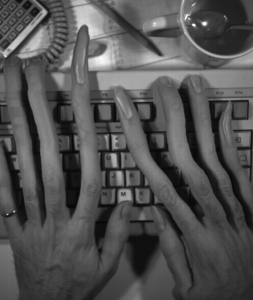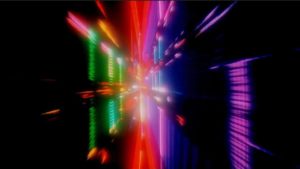
With tools like photoshop, making abstract art has become increasingly easier to make. It created a revolution in not just digital mediums, but all art and graphics. Darkroom techniques that were unreliable or difficult for beginners to learn, such as Dodging and Burning, can easily be replicated perfectly and one hundred percent more reliable. The ability to undo changes and revert to the original at no expense allows artists to experiment further since there is no financial risk involved. Although some people cling to the old ways for various reasons, most people, if not all, cannot perceive the difference between a technique done digitally or by hand; for example, filters can be applied on the camera, on the enlarger in the darkroom, or in photoshop, and at all stages, the results can be virtually identical (I say can be, since not all filters can be used at the enlarger, or are only able to be used then).
The image above is one of my more popular abstract photographs. I created it without photoshop or photo editing software. It uses a technique called “Kinetic Photography”. The general process is simple, use a long shutter speed and move or shake the camera while the shutter is released. There are ways to manipulate this to get various desired effects, such as length of the shutter speed, f-stop, lenses, filters, ambient light, subject light, and how one holds the camera. Holding by the straps versus holding the body versus throwing the camera yield very different results. For the photograph above, I used a 10 second shutter speed, f-stop 22, completely dark room, an iPhone flashlight, no zoom or filter, and I held the camera by the body. Movement is critical, as I had to move my entire body to prevent remaining still on any one spot too long. For this image, flares or spots made by the flashlight were undesired. Holding by the straps and shaking is much easier to prevent such effects, but there is little to no control over the final image.
There are many other techniques that can produce extremely abstract or bizarre images. The best example is “Slit Scan Photography”. This technique is quite old and more ubiquitous than most imagine. A great example of how this technique is still used is panorama photography. The iPhone uses something similar for its panorama mode. Slit scan works b y hav
y hav ing a small opening (or slit, usually a few milimeters), which is the only area that allows light to enter the camera. This opening moves across the camera as the shutter is open. This can be used to take up more space and make a larger or longer photograph. If the subject moves during this process, some strange and unnatural looking results can be created, such as the image to the left of a woman’s fingers on a keyboard. While this can definitely replicated easily with photoshop, and requires equipment and planning to do physically, there can be some key differences between the digital and the physical. Digitally, one must be sure to only manipulate the subject or at minimum detach the subject from the background and then edit, or else the distortion will affect more. Also, through physical, the shadows of the subject or any lighting distortions will be done for the artist since it was manipulated at the time of capture. This technique can also be used in film. Some may recognize the image on the right being the star gate sequence from Stanley Kubrick’s revolutionary 1969 film, 2001: A Space Odyssey. This sequence was made using the same technique, modified for cinematic use. The camera was placed on a track that allowed it to move back and forth within twenty to fifty feet of the slit. Behind the slit (which was a few inches wide), were various works of art or anything visual that had a powerful light shining through it. On the sides of the slit was black, as well as well as there was no ambient light. The camera would move closer as the images behind the slit would move.
ing a small opening (or slit, usually a few milimeters), which is the only area that allows light to enter the camera. This opening moves across the camera as the shutter is open. This can be used to take up more space and make a larger or longer photograph. If the subject moves during this process, some strange and unnatural looking results can be created, such as the image to the left of a woman’s fingers on a keyboard. While this can definitely replicated easily with photoshop, and requires equipment and planning to do physically, there can be some key differences between the digital and the physical. Digitally, one must be sure to only manipulate the subject or at minimum detach the subject from the background and then edit, or else the distortion will affect more. Also, through physical, the shadows of the subject or any lighting distortions will be done for the artist since it was manipulated at the time of capture. This technique can also be used in film. Some may recognize the image on the right being the star gate sequence from Stanley Kubrick’s revolutionary 1969 film, 2001: A Space Odyssey. This sequence was made using the same technique, modified for cinematic use. The camera was placed on a track that allowed it to move back and forth within twenty to fifty feet of the slit. Behind the slit (which was a few inches wide), were various works of art or anything visual that had a powerful light shining through it. On the sides of the slit was black, as well as well as there was no ambient light. The camera would move closer as the images behind the slit would move.
A third technique to create somewhat abstract photographs without photoshop is called the “Harris Shutter”. This is a fairly easy technique to do, both physically  through photoshop. Unfortunately, minor amounts of photoshop are needed if a digital camera is used. To do this, one needs three filters: red, blue, and green. Using a tripod to keep the camera stationary, the photographer takes three pictures of the subject, one with each filter. With film, the three negatives are placed on top of one and another and used to burn the paper as if it were one negative. Through digital, there are two ways. The first is to place each image over one and another at thirty three percent opacity. The second way is to put each image as the corresponding color channel (i.e red in the red channel). The interesting aspect of this technique is that movement can easily be expressed, and unnatural colors are created by movement between the three images. If nothing changes, then there is no effect on the end photograph. Fire, water, and faces tend to be the more popular subjects of this technique, as change occurs frequently.
through photoshop. Unfortunately, minor amounts of photoshop are needed if a digital camera is used. To do this, one needs three filters: red, blue, and green. Using a tripod to keep the camera stationary, the photographer takes three pictures of the subject, one with each filter. With film, the three negatives are placed on top of one and another and used to burn the paper as if it were one negative. Through digital, there are two ways. The first is to place each image over one and another at thirty three percent opacity. The second way is to put each image as the corresponding color channel (i.e red in the red channel). The interesting aspect of this technique is that movement can easily be expressed, and unnatural colors are created by movement between the three images. If nothing changes, then there is no effect on the end photograph. Fire, water, and faces tend to be the more popular subjects of this technique, as change occurs frequently.
There are many other ways to create abstract photographs. But the common elements between the different techniques tends to be manipulating time or how light enters the camera. One technique even has the photographer detach the lens partially from the camera so some of the light enters the shutter without going through the lens first. I only briefly mention this technique since it is very uncommon and not an easy technique to learn. I have tried it myself and have been largely unsuccessful. The main reason I became interested in abstract photography is because it is the complete opposite of how most perceive the medium; most see photography as the one of the few completely “truthful” mediums. A photo shows exactly what happened at the exact moment of the capture. In a way abstract photography is that too. However, the exact “moment” is not clear. With kinetic photography, it is many moments layered at once. With slit scan photography, each delta (size determined by the relative slit size) on the image is its own moment linearly stitched in with others. And with the Harris shutter, it is 3 moments blended together to give the illusion of one moment.
(First image is my own, If you want one or any similar ones, feel free to ask)
(Image of woman’s fingers on keyboard from wikipedia: https://en.wikipedia.org/wiki/Slit-scan_photography#/media/File:Keyboard_eq1985.png)
(Image of star gate sequence from 2001 a space odyssey: https://nofilmschool.com/2013/08/learn-how-to-create-slit-screen-sequences)
(Image of fire from the jar is from: https://expertphotography.com/how-to-the-harris-shutter-effect/)